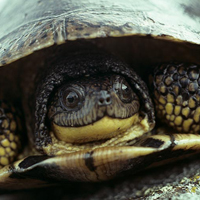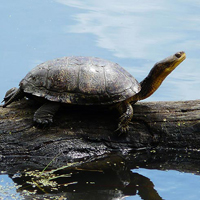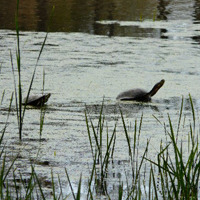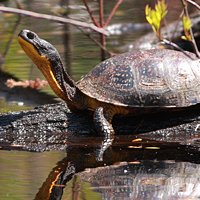Blanding’s Turtle
Scientific name: Emydoidea blandingii




Cover photos credit: Brendan Toews (left), Michael Oldham (middle-left), Allen Woodliffe (middle-right) and Larry Watkins (right)
Status
Threatened
“Threatened” means the species lives in the wild in Ontario, is not endangered, but is likely to become endangered if steps are not taken to address factors threatening it.
Date added to the Species at Risk in Ontario List
Blanding’s Turtle was already assessed as threatened when the Endangered Species Act took effect in 2008. A reassessment in May 2017 confirmed this status.
Read the assessment report [PDF].
What it looks like
Blanding’s Turtle is a medium-sized turtle easily identified by its bright yellow throat and chin. Unlike most Ontario turtles that have wide, flatter shells, Blanding’s Turtle has a domed shell that resembles an army helmet.
Its shell is black to brown with yellow flecks and streaks and can reach 27 centimetres long. Its head and limbs are black-grey and the bottom shell is rich yellow.
Where it lives
Blanding’s Turtles live in shallow water, usually in large wetlands and shallow lakes with lots of water plants.
It is not unusual, though, to find them hundreds of metres from the nearest water body, especially while they are searching for a mate or traveling to a nesting site.
Blanding’s Turtles hibernate in the mud at the bottom of permanent water bodies from late October until the end of April.
Where it’s been found in Ontario
Blanding’s Turtle is found in and around the Great Lakes Basin, with isolated populations elsewhere in the United States and Canada.
In Canada, Blanding’s Turtle is separated into the Great Lakes-St. Lawrence population and the Nova Scotia population.
Blanding’s Turtles can be found throughout southern, central and eastern Ontario.
What threatens it
The most significant threats to Blanding’s Turtle are loss or fragmenting of habitat, motor vehicles, and raccoons and foxes that prey on eggs.
Illegal collection for the pet trade is also a serious threat. Blanding’s Turtles are slow breeders—they don't start to lay eggs until they are in their teens or twenties—so adult deaths of breeding age adults can have major impacts on the species.
Action we are taking
This species and its habitat are protected under Ontario’s Endangered Species Act, 2007 (ESA).
The ESA also requires us to prepare recovery guidance for threatened species such as Blanding’s Turtle.
All species listed on the Species at Risk in Ontario List may be eligible for consideration for government funding through the Species at Risk Stewardship Program.
Recovery strategy
A recovery strategy advises the ministry on ways to ensure healthy numbers of the species return to Ontario.
Read the executive summary and the full document (December 5, 2019).
Government response statement
A government response statement outlines the actions the government intends to take or support to help recover the species.
Read the government response statement (September 8, 2020)
Habitat protection
General habitat descriptions are technical, science-based documents that provide greater clarity on the area of habitat protected for a species.
Read the general habitat description (July 2, 2013)
Species at Risk Conservation Fund
Blanding’s Turtle has been designated as an eligible species for the Species at Risk Conservation Fund.
Learn more about how the Species at Risk Conservation Fund and the Species Conservation Action Agency is working to help protect and recover conservation fund species.
What you can do
Report a Sighting
Submit your observations of species at risk to the Natural Heritage Information Centre (NHIC), which is Ontario’s conservation data centre. Join the “(NHIC) Rare Species of Ontario” project in iNaturalist to make submitting your observations quick and easy.
Volunteer
Volunteer with your local nature club or provincial park to participate in surveys or stewardship work focused on species at risk.
Be a good steward
- Blanding’s Turtle on your land, you may be eligible for stewardship programs that support the protection and recovery of species at risk and their habitats.
- As with many other rare plants and animals, Blanding’s Turtle is at risk due to the loss of wetland habitat. You can help by protecting any wetlands and surrounding natural vegetation on your property.
- Every year, turtles all over the province must cross busy roads to get to their nesting sites. Female Blanding’s Turtles sometimes mistake gravel shoulders of roads as good nesting sites. Watch for turtles on the roads, especially between May and October.
- Never buy native species of turtles or any turtles that have been caught in the wild. If you see native species of turtles for sale in a pet store or food market, use the Report pollution online form or call the public reporting hotline toll-free at
Toll-free: 1-866-MOE-TIPS (663-8477) 24 hours a day, seven days a week. You can also contact your local ministry district office if you need additional help to report impacts to species at risk or its habitat. - The Ontario Reptile and Amphibian Atlas also collects observations of all Ontario reptiles and amphibians. Submit your observations.
- Visit the Toronto Zoo Adopt-a-Pond website to learn more about Ontario’s rare turtles, their habitat related conservation initiatives.
Report illegal activity
Report any illegal activity related to plants and wildlife to
Quick facts
- The size of the Great Lakes-St. Lawrence Blanding’s Turtle population is impossible to estimate accurately, as only limited data are available.
- It can take a female Blanding’s Turtle up to 25 years to mature. This long-lived species can survive in the wild for more than 75 years.
- Unlike other Ontario turtles, the bottom shell is hinged so that some Blanding’s Turtles can completely close their shell after pulling in their head and feet.